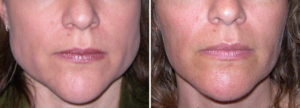The masseter muscle is a very large and thick muscle that occupies the outside of the mandible back by the angle of the jaw. It is one of the major muscles responsible for moving the jaw. Because of where it is located, it can contribute significantly to fullness of the lower face. When it is enlarged or naturally larger (as in some ethnic groups), it can be extraordinarily obvious and contribute to a more square facial shape.
Reduction of a large masseter muscle has historically been difficult. Surgical reduction is possible but it is associated with a significant amount of swelling and a long recovery period. Restricted oral opening and persistent trismus make a subtotal myectomy of the masseter very unappealing.

In the June 2010 issue of the journal Plastic and Reconstructive Surgery, these very questions were addressed. A published study retrospectively 121 patients who were treated for more than one year with botulinum injections (Dysport) into the masseter muscles. (100u to 140 u per side) The patient’s masseter muscle thickness was measured by ultrasonography. The patients received variable numbers of injections from two to eight. Overall masseter muscle size was reduced from roughly 13.5 to just under 10 mms. With increasing number of injections came further muscle thickness reduction.
This study shows that sustained effect of masseter muscle reduction can be obtained by repeated muscle paralyzing injections. Because the sample size is inconsistent with irregular visit intervals and injection periods as well as patient ages and muscle thicknesses, no firm dose or injection interval could be specifically recommended. One interesting graph shown in the paper demonstrates a predictive relationship of the maximal effect and the sustained effect. This graph suggests that three injection sessions during the first year leads to a sustained muscle reduction effect. This sustained amount of muscle reduction is not as great as that seen in the first few months (maximum effect) but could be maintained out to greater than 36 months after the first year’s injections.
One of the interesting questions is why would masseter muscles shrink or reduce in size if the same thing is not seen with the muscles of facial expression? If botulinum toxins can reduce muscle volume, why do not wrinkle treatments need less toxin dose and are maintained longer with repeated injections? One very plausible explanation is that the type of muscle fibers are quite different. Muscles of facial expressions are faster twitch fibers and are structurally different than that of the master muscles. All facial muscles are not created equal. Another difference in the sustained effects between the two muscles is in how they recover. The assessment of facial expression muscle activity is when they start working again, The assessment of masseter muscle recovery from injection therapy is a change in size which is quite slower, thus the longer effect than that seen in wrinkle treatments.
Dr. Barry Eppley
Indianapolis, Indiana


